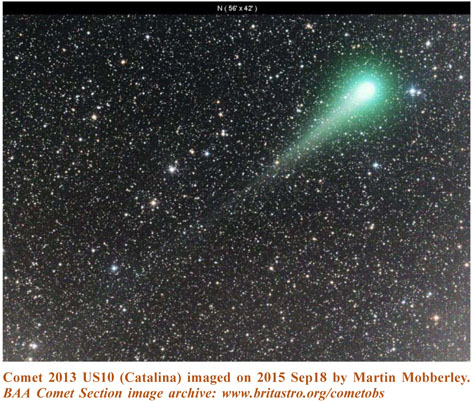Comet prospects for 2016
2015 November 18
 Comet 2013 US10 (Catalina) could be a binocular or naked eye object at the beginning of the year. In the southern hemisphere 2013 X1 (PanSTARRS) could be visible in binoculars during their winter. 45P/Honda-Mrkos-Pajdusakova is the brightest of the periodic comets, and may be visible in binoculars at the end of the year, though it will be relatively close to the Sun.
Comet 2013 US10 (Catalina) could be a binocular or naked eye object at the beginning of the year. In the southern hemisphere 2013 X1 (PanSTARRS) could be visible in binoculars during their winter. 45P/Honda-Mrkos-Pajdusakova is the brightest of the periodic comets, and may be visible in binoculars at the end of the year, though it will be relatively close to the Sun.
These predictions focus on comets that are likely to be within range of visual observers, though comets often do not behave as expected and can spring surprises. Members are encouraged to make visual magnitude estimates, particularly of periodic comets, as long term monitoring over many returns helps understand their evolution. Guidance on visual observation and how to submit estimates is given in the BAA Observing Guide to Comets. Drawings are also useful, as the human eye can sometimes discern features that initially elude electronic devices.
Theories on the structure of comets suggest that any comet could fragment at any time, so it is worth keeping an eye on some of the fainter comets, which are often ignored. They would make useful targets for those making electronic observations, especially those with time on instruments such as the Faulkes telescopes. Such observers are encouraged to report electronic visual equivalent magnitude estimates via the Comet Observations Database (COBS). When possible use a waveband approximating to Visual or V magnitudes. These estimates can be used to extend the visual lightcurves, and hence derive more accurate absolute magnitudes.
In addition to the information in the BAA Handbook and on the Section web pages, ephemerides for the brighter observable comets are published in the BAA Circulars, and ephemerides for new and currently observable comets are on the JPL, CBAT and Seiichi Yoshida’s web pages. A new revised version of the BAA Observing Guide to Comets should soon be available from the BAA online shop or the BAA office. (continued….)
Jonathan Shanklin, Comet Section Visual Coordinator
(Login or click above to view the full article in PDF format)
| The British Astronomical Association supports amateur astronomers around the UK and the rest of the world. Find out more about the BAA or join us. |
